Catalan culture in Collioure
August 28th, 2018Where has the train driver gone?
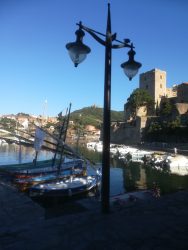
Collioure Castle
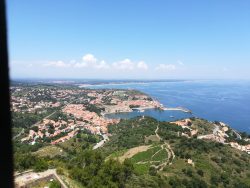
Collioure, view from Fort St. Elme
We are on the high speed train from Girona to Perpignan but have stopped at Figueres near the French border. Apparently the train driver has left the train and not returned. We are stranded and we wait an hour and then two hours and eventually a new driver arrives by taxi! The original driver was protesting about his work terms and conditions. In the meantime other passengers have long since left and caught a taxi to Perpignan airport to ensure they did not miss their flights.
At Perpignan we join the local train to the beautiful French coastal town of Collioure. We soon find our fisherman’s cottage and look out of the bedroom window at the stupendous view of the sea bay and castle. Some describe Collioure as the Saint Tropez of south west France but less crowded. If you would like to stay in Airbnb in this part of France please click here
Moules et frites
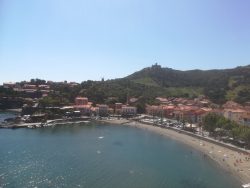
Collioure sea bay
Our first meal in Collioure is moules et frites in a café overlooking the bay. It brought back happy memories of a walking holiday with my dad in Normandy and most evenings we enjoyed eating ‘moules et frites’. At the time he shared his memories of World War II when serving in the RAF. He was dropped behind enemy lines to try and find a way through the Nazi German forces at Dunkirk. They soon discovered this wasn’t possible and walked all the way from the Dunkirk area, skirted around Paris and finally arrived in Normandy. They escaped from Cherbourg and returned safely to England before the Germans reached Normandy. I wish I had spent more time talking to him about his time in World War II. Typical of his generation he was very understated and did not believe his experiences were that remarkable.
On our first day we visit the local market. We buy some cold sausage and organic cheese. No prices are displayed at this stall and we are surprised to discover it costs 35 Euros. Although the food is quite tasty it is not that good! It seemed like a bit of a scam but we were too embarrassed to say no as he had already cut & wrapped the cheese and meat. We avoid this stall on future visits and instead buy very good value fruit, such as juicy melons and tomatoes, and vegetables which we eat at lunchtimes. This is a good alternative to eating ‘out’. The cost of eating at local restaurants seems very expensive compared with Girona in Spain where we had previously been staying.
A little train to top of the mountain
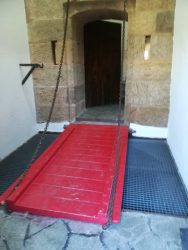
Drawbridge at Fort St Elme
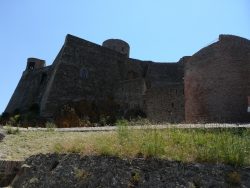
Fort St. Elme
If you do not do anything else when visiting Collioure make sure you visit the Fort St. Elme on the top of the hill overlooking the town. The fort houses an interesting museum of weapons but the best part is the stunning view over the town. It is a great place for children to visit who can try out various activities such as archery.
The easiest way to reach the fort is to catch the little train which runs up to the top of the mountain along the local roads and visits various other places of interest. The walk down the hill is very steep and you need to be wearing sturdy footwear to ensure you don’t slip over. Unfortunately for me I was wearing sandals and therefore had to proceed very slowly and in some parts almost crawl over rocks.
On the way down you also come to a 14th century windmill which a party of school children were exploring. They seemed to enjoy running around the surrounds of the windmill.
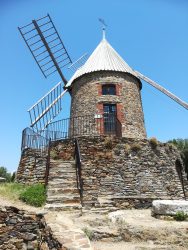
14th century windmill, Collioure
The one Euro bus
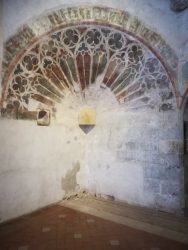
Palace of the Kings of Majorca
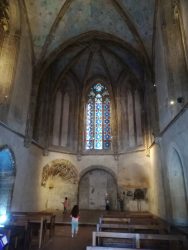
The Palace of the Kings of Majorca
A great way to explore the local area around Collioure by public transport is to use the one Euro bus. This runs at least once an hour (except Sundays) to various local places such as Port Vendres, Perpignan, Argelès-sur-Mer and Banyuls-sur-Mer.
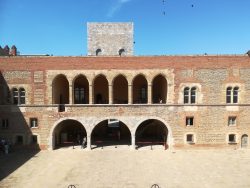
Palace of the Kings of Majorca
The journey to Perpignan by bus is a bit tortuous as it stops at a lot of places along the way and can take well over an hour. It is much quicker by train but more expensive and when we were there a train strike on a number of the days made it difficult to rely on the train. Perpignan is well worth a day visit and in particular the Palace of the Kings of Majorca. The building of the Palace started in 1276 and was completed in 1309. It was built by King James of Majorca and clearly demonstrates the Islamic influence in the area.
Perpignan Cathedral
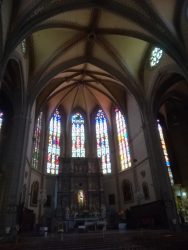
Perpignan Cathedral
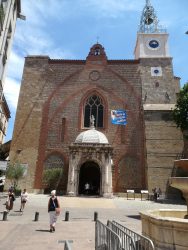
Perpignan Cathedral
Perpignan seems more like a working town than a tourist destination. It is however good to sit by the River Tet in one of the local cafés drinking coffee. Or is it the tributary of the Tet, the River Basse? I am not sure, perhaps a local person can let me know. The local cathedral is worth a visit and not far from the tourist information centre. The latter had just moved premises but there was no map at the old centre to show you how to get to the new one!
Although it is free to visit the Cathedral there are very few people inside. This Roman Catholic Cathedral was begun in 1324 by King Sancho of Majorca and later finished in the 15th century. Some of the current features such as the portico and clock tower date from the 18th century.
Port Vendres & its surprising history
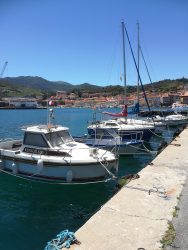
Port Vendres
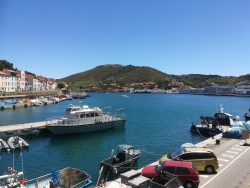
Port Vendres
My favourite place in the Catalan region of Collioure is Port Vendres. From a distance it looks like a dubious seaside place with lots of newly built apartments. There is good reason for this as the harbour area was bombed by the Nazi Germans in World War II. It feels like an authentic fishing port with tourism as an added bonus. Unlike many of the local coastal towns I am told it has a vibrant community in the winter as well as the summer.
The Germans occupied the port from 1942 to 1944 and destroyed the harbour when they left so it could not be used by the Allies. It is one of the few deep sea harbours in this part of France and therefore could accommodate the bigger warships and today welcomes cruise ships. When you arrive in the port, it is about 50 minutes walk from Collioure, you discover a delightful fishing village with many of the fishermen’s terraced houses still intact. It is much more rustic than Collioure and the local cafes and restaurants serve a variety of seafood dishes, including oysters, at a very reasonable price.
Monument to a soldier?
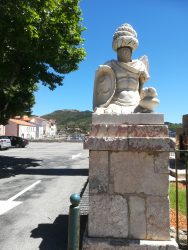
Monument, Port Vendres
Just outside the harbour area in Port Vendres is a monument to a soldier wearing a turban. I am assuming this is recognition of the association between the port and Algeria, as a point of embarkation for French troops, as part of the twentieth century Algerian war of independence (1954 to 1962).
At the other end of the harbour is a plaque paying tribute to Francois Joly, ‘martyr de la resistance’. Francois Joly was obviously a member of the French resistance movement but there is no information on how he died.
The French wording on the bottom plaque is explaining the German bombing of the harbour leading to its destruction in 1944.
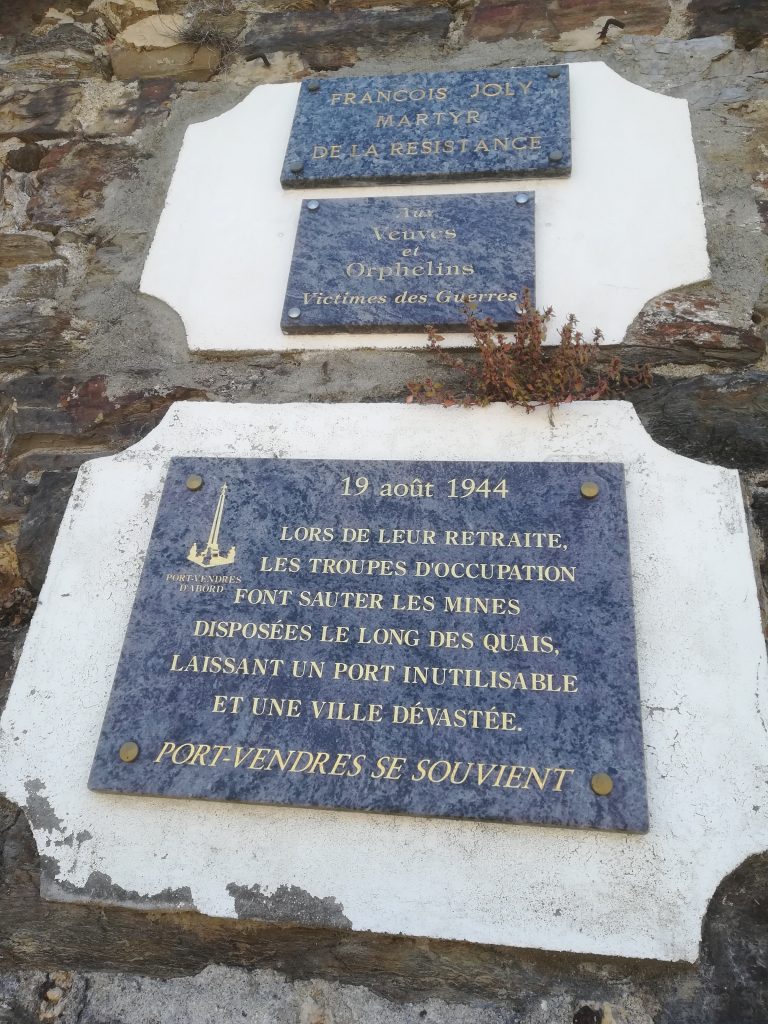
Plaque, Francois Joly & the destruction of the port
French Algerian refugees
I love the quote at the bottom of this plaque ‘Remembering is a renaissance, forgetting is like being exiled again’. It commemorates the 900 Algerian French who arrive in this port in 1962 on the boat Manuel Campillo as refugees from the Algerian war. Somehow I found the fact that this monument is here is so uplifting to the spirit. The town is acknowledging its rich heritage. Interestingly the plaque is dated 2012; was there any formal recognition prior to this date?
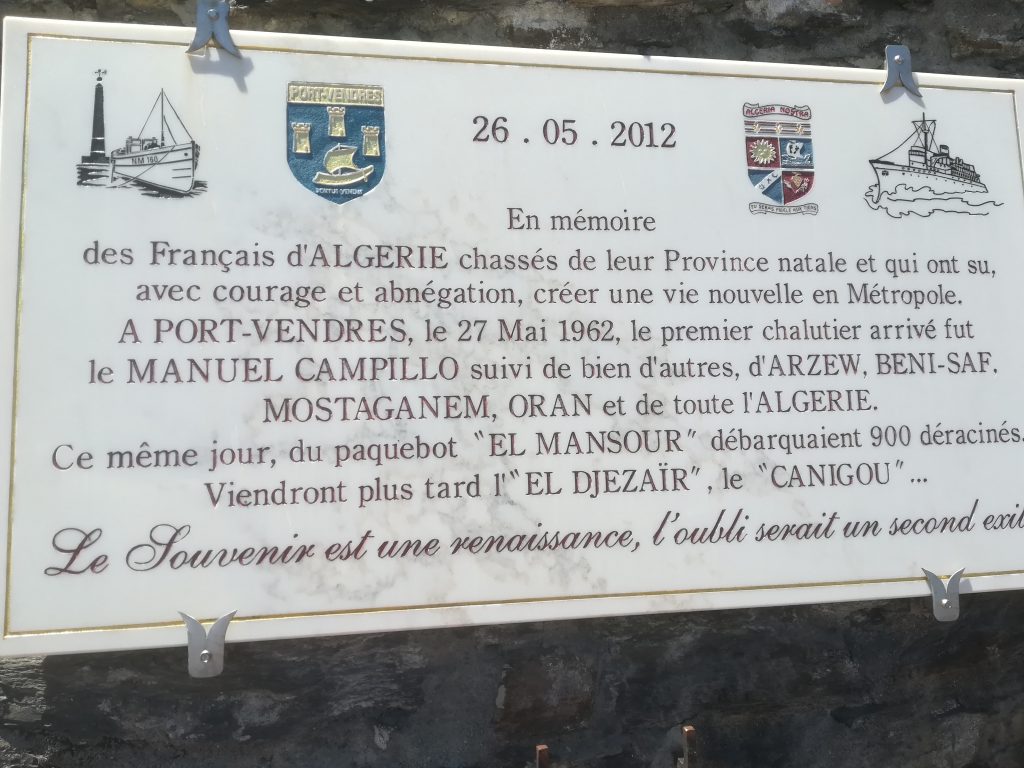
Plaque, Port Vendres, remembering the French Algerian refugees
Winston Churchill
When you are travelling it is surprising how often you come across references to Winston Churchill. This is not only in mainland Europe but also in places like Marrakesh in Morocco. He used to go to Marrakesh not only in his official capacity but also to relax and paint. Hotels and restaurants proudly record his visits. Here you have the famous quote from Winston Churchill ‘Never in the history of man have so many owed so much to so few’. You have to admit Churchill had a way with words. Can you imagine a modern day political leader reaching such eloquence?
The plaque below tells the story of the French military leader who allowed the boats to escape the blockade of the port in 1941 so they could join the allied forces. On board the boats were Polish and French airmen on route to Gibraltar so they could fight against the Third Reich. The names of the 16 French airmen who did not return are listed.
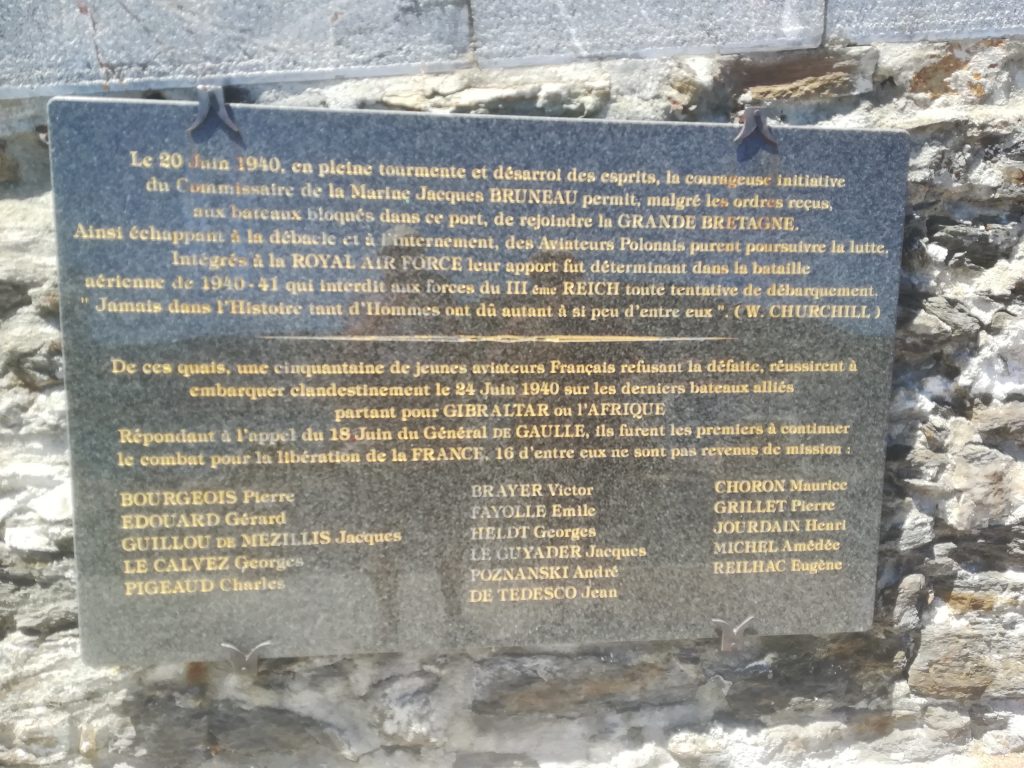
Plaque remembering the blockade of Port Vendres in 1941
Festival of St Joan
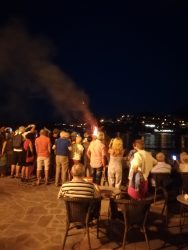
Festival of St Joan
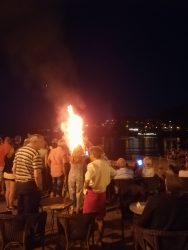
Festival of St Joan
One of the delightful traditions celebrated in Collioure in June is the Festival of St Joan on the 23rd of June. A fire is lit on the beach in the evening to celebrate the longest day of the year and the shortest night. It is the summer solstice. The fire is a little like burning a Christmas tree as fire wood is burnt with the fire brigade in attendance to ensure there is no danger of the fire spreading. All generations of families join in the fun and there is a real sense of community. It is accompanied by music, fireworks and dancing. It is more a Catalan tradition than a specifically French festival, as it is also celebrated in many parts of Spain. Essentially it is a celebration of light over darkness.
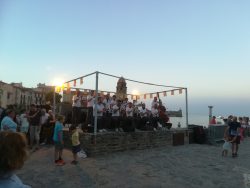
Traditional singing at the St Joan Festival
Argelès -sur-Mer
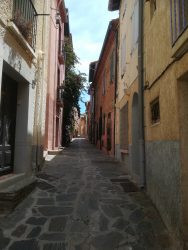
Argeles -sur-Mer
One of the towns just up the coast from Collioure is Argelès -sur-Mer. You can take a boat trip from Collioure harbour or catch the one Euro bus. The bus is cheaper but the boat trip, which is about 40 minutes, is a pleasant way to view the coast line from the sea. What the local tourists do not understand is where the centre of the village is? It is very spread out with a modern part by the sea with a range of shops, caravan and camp sites. This is very popular with young families. We were trying to find the old centre of the village but no one we met seemed to know where it was. We discovered it is a two mile walk from the modern part of the town. This is exhausting in the heat of the day.
The bus does go near to the old town but it is not very obvious where the bus stop is from the timetable. However it is well worth the effort to visit the old town which is a delightful place with traditionally built houses, church and a lovely roadside café. At the time we were visiting everyone was watching the football world cup.The local French villagers were in good spirit as the French football team were winning.
Château Royal de Collioure
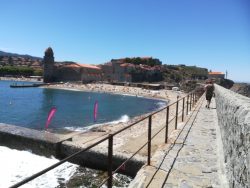
The promenade behind the Eglise Notre Dame
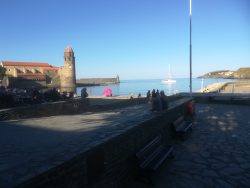
Eglise Notre Dame, Collioure
The Château Royal de Collioure is the castle that dominates the sea bay in Collioure. There is mention of a fortified site in Collioure in 673 but parts of this building may date from 12th century. It became known as the Royal Castle in 1345 (Wikipedia) and since that time has been fought over by various kings from Spain and France. It provides a stunning setting for the town and gives it a a certain style that other local seaside resorts are unable to match. It is good fun to explore the inside of the castle and walk the ramparts and cave-like rooms. The dramatic view of the town and sea from the top of the castle walls are well worth the small entrance fee alone.
There is also a modern art museum which includes paintings by Henri Matisse, with a peaceful and pretty garden outside providing a nice setting for a picnic. From here you can walk up the hill to the windmill and further along to Fort St Elme.
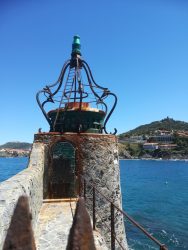
Collioure sea front
Another place featuring on the edge of the bay is ‘Eglise Notre Dame’. These are all lovely places to sit nearby in the evening and dine at one of the harbour bay restaurants, although you can eat sometimes a little more cheaply down one of the charming side streets. The only thing that irritated me is the French café owner’s habit of saying ‘sorry monsieur the table is reserved for eating only’, when you just want to stop for a quick drink. There are in fact several empty tables and when we walk by again about an hour later the same tables are still empty.
In many ways Collioure is a picture postcard holiday destination. However it may become a victim of its success with so many visitors and start to lose its identity as a classical Catalan seaside village, although the driver of the little train told me visitors were significantly down on previous years. This may be because in the previous weeks the weather had been unpredictable and therefore day visitors were probably discouraged from coming. It is certainly best to visit in early summer or autumn, if you can, and outside of July and August when it is less crowded.

